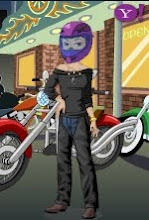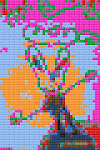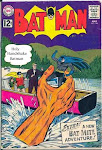
I am a total novice regarding comics. I am even worse figuring out manga. I tried to find out as much as I could about the genre. Scott McCloud an American cartoonist has published a book
Making Comics: Storytelling Secrets of Comics, Manga, and Graphic novels. At the end of the book is a section on
Understanding Manga. This is exactly what I needed. The following is a brief rundown on the history and nature of manga according to McCloud and Wired magazine.
There are two kinds of manga for ages 7-13, Shojo and Shonen. Shojo is mainly for girls under 12 and Shonen is for young boys. See
School library Journal for more definitions. Young readers often cross over the gender barrier. Shojo often is romantic, emotional, and sometimes magical such as
Sailor Moon and others. The action is shown in the expression of the faces and the reader is inside the characters head. In Shonen the action is more physical. A specific method of drawing shows the motion, plus the use of action words such as, wham, bang, klank make it appealing to boys. With Shonen the reader is inside the action. This is the difference between North American Comics (Captain America etc.) and Japanese comics. With North American comics the reader is an observer. In manga the reader is a participant. In Japan this has led to thousands of fanfic artists (
Doujinshi) who make their own manga stories using preconceived characters and situations from sold books. These are made, discussed, compared, and sold at huge comic markets. Its an inexpensive enterprise because its all in black and white. Characters are scanned, changed, and recopied on a copy machine for limited distribution. This occurs without the interference of the Japanese comic industry as long as fans only scan a few and don't mass market them. They do have copyright laws but they are not enforced as long as the unspoken rules are not broken. According to McCloud the reason manga is loved is because the reader feels they are part of the story. It's all about participation. The fans become the writers. Some of the techniques used are large expressive eyes, details, use of wordless panels, and the use of streaked backgrounds to give the reader a sense of motion. By the way
Making Comics is an informative book, of course it is in comic format. For eye opening information on Manga mores, styles, pitfalls, and titles for under 13's checkout
Great Manga for Preteens.Wired magazine (Nov. 2007) reports manga began with the animation market now known as anime which was television and movies of cartoon characters. Tetsuwan Atom (Mighty Atom) was the first weekly cartoon made for Japanese TV. It was sold in America as Astro Boy. The artist was inspired by our own Walt Disney. Go Figure.
Little known strange & weird facts according to Wired:Hiroshima has a public library totally devoted to manga . In the United Kingdom, the Catholic church is using manga to recruit new priests.American teenagers can read graphic novels which each contain 300 words often found on the SAT and ACT: Warcraft, Dragon Hunt, Psy-Comm, and Van Von Hunter, manga titles published by Kaplan and Tokyopop.

















